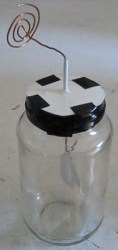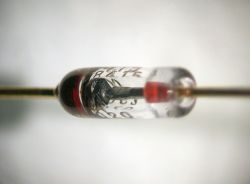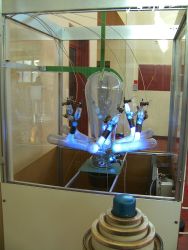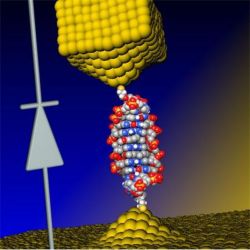The history of the diode is a fun one as it’s rife with accidental discoveries, sometimes having to wait decades for a use for what was found. Two examples of that are our first two topics: thermionic emission and semiconductor diodes. So let’s dive in.
Vacuum Tubes/Thermionic Diodes
Our first accidental discovery was of thermionic emission, which many years later lead to the vacuum tube. Thermionic emission is basically heating a metal, or a coated metal, causing the emission of electrons from its surface.

In 1873 Frederick Guthrie had charged his electroscope positively and then brought a piece of white-hot metal near the electroscope’s terminal. The white-hot metal emitted electrons to the terminal, which of course neutralized the electroscope’s positive charge, causing the leafs to come together. A negatively charged electroscope can’t be discharged this way though, since the hot metal emits electrons only, i.e. negative charge. Thus the direction of electron flow was one-way and the earliest diode was born.
Thomas Edison independently discovered this effect in 1880 when trying to work out why the carbon-filaments in his light bulbs were often burning out at their positive-connected ends. In exploring the problem, he created a special evacuated bulb wherein he had a piece of metal connected to the positive end of the circuit and held near the filament. He found that an invisible current flowed from the filament to the metal. For this reason, thermionic emission is sometimes referred to as the Edison effect.

Vacuum tubes began to be replaced in power supplies in the 1940s by selenium diodes and in the 1960s by semiconductor diodes but are still used today in high power applications. There’s also been a resurgence in their use by audiophiles and recording studios. But that’s only the start of our history.
Solid-State/Semiconductor Diodes

This is what became known as the cat’s whisker detector and was used in 1894 for experiments with microwaves. In 1906, G.W. Pickard patented a silicon detector while Henry Harrison Chase Dunwoody patented the carborundum detector. And so began the widespread use of the cat’s whisker in crystal radios which were made in the millions.

After World War II, germanium diodes that didn’t have a point-contact that needed adjusting were manufactured in large quantities and proved to be as sensitive as galena. Since they didn’t need the adjusting that the cat’s whisker detector used, that began the age of crystal radios with modern semiconductor diodes.
Mercury-Arc Rectifier

A scary sounding and eerie looking type of diode was the mercury-arc rectifier. This was invented in 1902 by Peter Cooper Hewitt and developed in the 1920s and 1930s. These were used until the 1970s for converting high voltage AC and high current AC into direct current. They consisted of a container of mercury vapor provided by a pool of mercury at the bottom. The pool of mercury also acted as the cathode. Also in the container were carbon anodes. The mercury emitted electrons freely whereas the anode emitted very few. An arc was struck at the pool, which ionized the mercury vapor between the cathode and the anode, creating the conducting path. Applications included battery charging, arc lighting systems, trolleys, subways and electroplating.
Mercury-arc rectifiers were replaced in the 1970s by thyristors. But since thyristors have a gate contact in addition to the anode and cathode, we won’t cover them here.
Copper-Oxide And Selenium Diodes
Selenium diodes are another example of an early discovery followed by a delayed practical use. The first selenium diode was constructed in 1886 by C.E. Fitts but was not made practical until the 1930s. It eventually found use in radios, high current battery chargers, televisions and photocopiers. They were made of a steel plate with a layer of selenium and then a cadmium-tin layer between which a layer of cadmium-selenide formed. This selenium and cadmium-selenide formed a semiconductor-semiconductor junction. They could be easily stacked indefinitely to withstand high voltages. They were replaced in the 1960s by silicon rectifiers which have a lower voltage drop. In 1961 IBM tried to develop computer logic using selenium diodes due to their low cost but they proved to be not reliable and were replaced with silicon diodes.
Copper-oxide diodes were invented around the same time as selenium diodes and had similar uses. In their case the copper-oxide layer on copper metal formed the semiconductor layer. Like selenium diodes, they could be stacked to withstand high voltages. These also were replaced by silicon diodes.

Schottky Diode
It’s perhaps hard to find who invented the Schottky diode because even the cat’s whisker detector is a point-contact Schottky diode. A Schottky diode is formed of a metal in contact with a moderately doped n-type semiconductor and cat’s whiskers fits that description. The diode is named after German physicist Walter H. Schottky who came up with physics dealing with the metal-semiconductor junction.
DNA nano-diode

And why not end this history of the diode with some fun recent history? Published in April 4, 2016 in the journal Nature Chemistry, researchers from the University of Georgia and Ben-Gurion University reported that they have made a diode from DNA. They did this by inserting two small coralyne molecules at specific locations in a custom-designed 11-base-pair DNA duplex. When 1.1V was applied across the structure, fifteen times higher current flowed in one direction versus the other depending on the polarity. This may have an impact on the development of molecular electronic devices, but as we saw above, there’s sometimes a delay before the practical application. But as we also know, it’s worth the wait.
Conclusion
Where does word diode come from? William Henry Eccles, an English physicist, came up with it in 1919 by combining the Greek roots di, meaning ‘two’, and ode, meaning ‘path’, though some sources say the ode was borrowed from ‘electrode’ which was coined by Michael Faraday.
There are many other types of diodes that can be covered but space and the difficulty in finding the history of some demands we stop here. However, if you know of any other interesting steps in the history of the diode we’d love to hear about them in the comments below.
















Avalanche diodes; Light-emitting diodes; Photodiodes; PIN diodes; Schottky diodes; Zener diode; Tunnel diodes – you haven’t begun to scratch the surface of this component, although you’ve made a good start.
Well, the title is “History of the Diode”, so I wouldn’t exactly expect them (although the DNA diode does kind of alter that). The Schottky diode is mentioned, and the others are mostly just (highly-specialised) variants of semiconductor diodes.
Hopefully this article is the first of a series on diodes.
My remarks were not intended as a criticism
I had considered LEDs, photodiodes and also photovoltaics but the list was getting too long, and the fact that they weren’t strictly used as diodes decided it. I couldn’t find any dates for Zeners, so they also didn’t make the cut. I hadn’t heard of PIN diodes before. Interesting. Thanks for the list.
There’s a book that covers the development of radar during WWII, and how it all impacted on the world afterwards.
They needed higher and higher frequencies to get proper definition, and while transmit tubes were made for the purpose, receiving tubes weren’t up to it. So they went back to cat’s whiskers, and used those as mixers in the receivers. But they actually went to semiconductor diodes, point contact but nothing for the user to adjust. This seems to have ben the impetus for the germanium diode after the War. And that in turn may have ben t catalyst for work on the transistor.
The concept of a diode mixer, no amplification ahead of it, remained for a long time. UHF tv tuners were, like that, maybe until the seventies. In amateur radio circles converters for 432MHz and up generally lacked n RF stage and went right to a diode mixer. Until the late fifties there was no amplification, ten the parametric amplifier came along. But it was transistors, that finally put rf amplification in such converters, slowly starting in the seventies.
Michael
Oops!
“John Ambrose Fleming had actually consulted for the Edison Electric Light Company from 1881-1991 but was now working for the Marconi Wireless Telegraph Company.”
110 years seems like a long time even for a company man.
Some claim that Edison was allegedly trying to ‘contact spirits’ when the phonograph was created, though he claimed later that he was making a joke…
Immortals among us! Thanks. Fixed.
Dufresnes, party of two…
What about the Dufresnes?
Smith, search party of two! The Dufresnes haven’t reported back.
Please, please hire a copy editor.
Then what would we commentors do?
Silicon (Si) vs. germanium (Ge) semiconductor diodes–
germanium is still the best crystal receivers, due to the extremely low forward voltage drop; 0.3v as opposed to 0.6v-0.7v.
Popular germanium diodes WERE the 1N34(A) and the 1N92. I say ‘were’, because you can still buy ‘gemanium’ diodes, with the old part numbers, from any number of rip-off artists–some with good names. The dead give-away: a forward voltage drop of higher than 0.3 volts.
Be careful out there.
I haven’t tried making a crystal radio using a Schottky diode, which has a much lower forward voltage drop than a regular silicon diode at higher currents, so I can’t comment on this aspect of receiver design. Perhaps another reader can, without guessing.
(Original comment should have said, “…germanium is still the best choice for…”. But you knew that)
Thanks for the tip on possible fakes diodes!
I’m always suspicious of a seller with only good reviews; they usually appear to have been written by the same person.
Also, be suspicious of a seller of ‘germanium diodes’ who won’t SAY what the forward voltage drop is at 10-100 ma (we’re not talking about high-current diodes, here).
Being a good hacker, simply look up the specs of a 1N34A or a 1N92 on DuckDuckGo (I’m tired of using the ‘G’ word) to get a reference point.
You’re not alone on that my friend.
Enough is enough. One should consider the consequences of disallowed
user autonomy.
I think “1N34” was long a code for “mall signal germanium”. Any time I saw the number, I knew what it meant. But it was ten or fifteen years abo that I saw a photo of a real 1N34, it is a distinctive pckage.
About the same time I went through a bunch of old boards looking for germanium diodes, and found quite a few, lingering on after silicon took over generally. If you look at germanium, schottky and silicon diodes with DMM set to the diode setting, and each type has a distinctive voltage shown.
Michael
I’ve bought 100 1n34a’s for a couple of dollars from AliExpress…and when I got them, they had the distinctive Ge diode package, as well as having a forward voltage drop of 0.3 V. So real Ge diodes are still out there, and still very very cheap. :)
Ahh, Selenium rectifiers. Not exactly great for any other diode use, great for turning AC to DC, and if it wasn’t for the joys of one going up and how hard they seem to be to find, I’d use mine for some vintage style project. Get them out of the parts box at least. That and the fact they age is a bit of an annoyance, if it’s going to age and wear out, may as well use tubes.
I’m told they absolutely stink when they burn out.
Not as bad as a T.V. “tripler”.
Some people say burning garlic.
Selenium is more dead skunk, rotten meat and a tire fire rolled into one with a side of cancer. It’s beyond awful when one goes up.
That said there is some cool old electronics that use them, but as others said, a modern diode and adjusting the circuit to account for the lower drop will be more reliable, cooler, more efficient, more compact…
You could cobble together some squares if metal and paint the right color (were they color coded? I have some and they are different colors), then drill a home through the middle to put a silicon diode.
I had some RCA Carfones sitting around for decades, finally deciding last year I’d never have a use for them. So stripped them. And the selenium rectifiers are waiting fir the next toxic waste collection.
Michael
Just be careful about doing that. You may overvolt your device if you don’t account for the voltage drop of the original rectifier, which can be quite significant.
A whole lot of negative Comments on here sadly, but I love these articles and they are well written!
Don’t mind them, they are just reverse biased.
Too much negative feedback perhaps…
+1 :-)
kek
You never know what you’ll find…
I decided to follow my own advice and search for ‘1N34A germanium diodes’ and I turned up this absolute treasure trove of information generated by an individual who has tested ALL kinds of diodes, in a quest to build a great crystal radio set. Check it out; this is one of those REALLY rare finds–
http://www.lessmiths.com/~kjsmith/crystal/dtest.shtml
That is certainly a very interesting page!
I know the guy doesn’t have unlimited time, and his interest is in crystal-radio (from what I gather – I didn’t bother with the rest of his site), but I would have liked to have seen more curves for some of the higher rated silicon diodes – I’ve heard the higher rated devices have a higher Vf…but I’ve never seen comparisons.
I would also liked to see more curves on LEDs, particularly high brightness red, green and amber, but also blue, IR and UV…
But he does have an interest in all kinds of diodes, as shown by his inclusion of data on ‘garden-variety’ LEDs–
“…Anyone used to working with Carborundum crystals or silicon diodes will be used to biasing their rectifier to get good sensitivity. These LED’s once on have a very sharp rise and with a proper bias should work quite well as detector diodes. As a bonus you will get a sweet glow as well…”
The best way to get data (curves) on high-current diodes is to be lucky enough to find a manufacturer’s old data sheet and download it. Motorola was well-known for publishing info-packed data sheets on components. (FYI–high-current diodes usually peaked out around 2 volts)
That site has just been bookmarked. :)
Don’t forget J.C. Bose, who used semiconductors to detect microwave power up to 60 GHz – in 1885!
http://hackaday.com/2016/01/19/j-c-bose-and-the-invention-of-radio/
https://www.cv.nrao.edu/~demerson/bose/bose.html
a) What kind of instrumentation was used to check that the the incoming RF was indeed 60 GHz, and not, say, 44.7 GHz–in 1885?
b) What kind of instrumentation indicated that he was, indeed, detecting 60 GHz, as opposed to, say, 440 Hz–in 1885?
Just asking.
The frequency was calculated as a function of the geometry of the apparatus
Interesting; thanks.
Diode mixers are still used in microwave transverters in the 24GHz and up range.
Really interesting is the use of diodes as multipliers to get RF up to several hundreds of GHz. Things get interesting when wavelength starts approaching the size of the diode. Virginia Diodes is one of the major players there.
See also: Step Recovery Diode.
I have seen schemes where forward voltage drop was brought close to 0 V by the use of voltage supply and a potentiometer. I wonder if such setup is better than Ge alone in detection of small signals.
Exactly. That is what the above-referenced gentleman meant when he wrote, “…Anyone used to working with Carborundum crystals or silicon diodes will be used to biasing their rectifier to get good sensitivity.”
Biasing any diode to negate the effect of the initial turn-on “knee” (approx. 300 mv–Ge–and 600 mv–Si) will improve the sensitivity of the detection scheme.
Of course, a bias source is an addition to a simple circuit. The only question becomes one of justification.
This reminds me that I have a box of diodes from the 1960’s and early 70’s. I should look them over and maybe test a few.
well it isn’t good for me soo… i don’t need it XD
The old blue Gillette razor blades were sometimes used to make detectors. I think the blue was iron oxide.
Since the article is a history re-computation. I must add the discovery of electron flow was observed by question the plating on the Glass of a DC light bulb. Plating was notice on the glass and always need the positive electrode. This concluded the electrons were racing past the positive pole and ending up on the glass. Then the vacuum tube with a control grid was discovered and on and on we go.